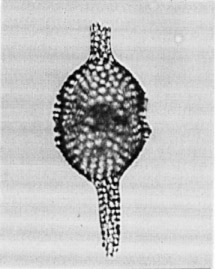 Didymocyrtis
tubaria (Haeckel)
Didymocyrtis
tubaria (Haeckel) Didymocyrtis
tubaria (Haeckel)
Didymocyrtis
tubaria (Haeckel)Pipettaria tubaria Haeckel, 1887, p.339, pl.39, fig.15
Cannartus tubarius (Haeckel) Riedel, 1959, p.289, pl.l, fig.2
Didymocyrtis tubaria (Haeckel) Sanfilippo and Riedel, 1980, p.1010
Cortical shell usually rather thick-walled, ellipsoidal with an equatorial constriction, with pores subcircular, irregular in size and arrangement, eleven to eighteen on the half-equator. At the equatorial constriction the shell wall is puckered to form coarse plicae, which Haeckel called "short conical protuberances." At each pole arises a subcylindrical spongy column with meshes much smaller than those of the cortical shell. Medullary shells two (perhaps only one in some specimens), of which the outer is spherical or lenticularly compressed (Riedel, 1959).
Based on 30 specimens. Length of polar columns 63-125 µm; median breadth 15-30 µm. Length of cortical shell 108-145 µm; maximum breadth 80-123 µm. Breadth of outer medullary shell 33-40 µm (Riedel, 1959).
In the region of the indistinct equatorial constriction, the shell wall is puckered to form coarse plicae. The spongy polar columns are narrow (Cannartus tubarius in Riedel and Sanfilippo, 1978a).
This species lacks the thickenings of the bulged part of the cortical shell on either side of the equator, which characterize Didymocyrtis violina. D(?) bassanii (Carnevale) (1908, p.21, pl.3, fig.12) lacks the longitudinal equatorial plicae, and usually has a longer, more dumbbell-shaped cortical shell and more inflated medullary shell (Sanfilippo et al., 1985).
The equatorial region of the cortical shell is puckered to a variable degree, forming coarse longitudinal plicae. The single or double medullary shell varies from moderately compressed (discoidal) to subspherical (Sanfilippo et al., 1985).
Didymocyrtis tubaria occurs in substantial numbers in assemblages of middle early to early middle Miocene age from low and middle latitudes of all oceans, including the Mediterranean region. Its morphotypic first appearance lies within the Stichocorys delmontensis Zone and its morphotypic last appearance lies within the Dorcadospyris alata Zone.
Didymocyrtis tubaria evidently evolved from early D. prismatica, by development of the pronounced, longitudinally puckered equatorial constriction.
Additional illustrations may be found in Riedel and Sanfilippo, 1970, pl.15, fig.2; Sanfilippo et al., 1973, pl.1, figs.9-10.